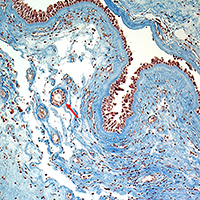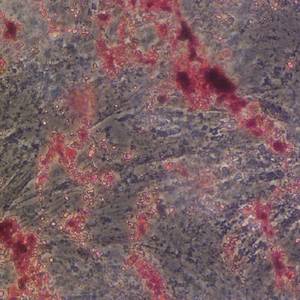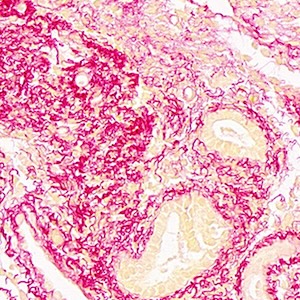Can the AGE/RAGE/ERK signalling pathway and the epithelial-to-mesenchymal transition interact in the pathogenesis of chronic rhinosinusitis with nasal polyps?

Submitted: 21 October 2019
Accepted: 14 January 2020
Published: 23 January 2020
Accepted: 14 January 2020
Abstract Views: 1617
PDF: 930
HTML: 7
HTML: 7
Publisher's note
All claims expressed in this article are solely those of the authors and do not necessarily represent those of their affiliated organizations, or those of the publisher, the editors and the reviewers. Any product that may be evaluated in this article or claim that may be made by its manufacturer is not guaranteed or endorsed by the publisher.
All claims expressed in this article are solely those of the authors and do not necessarily represent those of their affiliated organizations, or those of the publisher, the editors and the reviewers. Any product that may be evaluated in this article or claim that may be made by its manufacturer is not guaranteed or endorsed by the publisher.
Similar Articles
- X.C. Xu, X. Abuduhadeer, W.B. Zhang, T. Li, H. Gao, Y.H. Wang, Knockdown of RAGE inhibits growth and invasion of gastric cancer cells , European Journal of Histochemistry: Vol. 57 No. 4 (2013)
- D. Fanni, N. Iacovidou, A. Locci, C. Gerosa, S. Nemolato, P. Van Eyken, G. Monga, S. Mellou, G. Faa, V. Fanos, MUC1 marks collecting tubules, renal vesicles, comma- and S-shaped bodies in human developing kidney , European Journal of Histochemistry: Vol. 56 No. 4 (2012)
- F. Cau, E. Pisu, C. Gerosa, G. Senes, F. Ronchi, C. Botta, E. Di Felice, F. Uda, V. Marinelli, G. Faa, V. Fanos, C. Moretti, D. Fanni, Interindividual variability in the expression of surfactant protein A and B in the human lung during development , European Journal of Histochemistry: Vol. 60 No. 3 (2016)
- Yingzhuo Guo, Hua Wang, Sodium hyaluronate promotes proliferation, autophagy, and migration of corneal epithelial cells by downregulating miR-18a in the course of corneal epithelial injury , European Journal of Histochemistry: Vol. 67 No. 2 (2023)
- Simon Schöfer, Sylvia Laffer, Stefanie Kirchberger, Michael Kothmayer, Renate Löhnert, Elmar E. Ebner, Klara Weipoltshammer, Martin Distel, Oliver Pusch, Christian Schöfer, Senescence-associated ß-galactosidase staining over the lifespan differs in a short- and a long-lived fish species , European Journal of Histochemistry: Vol. 68 No. 1 (2024): 1954-2024: 70 Years of Histochemical Research
- A. Santoro, G. Pannone, M.E. Errico, D. Bifano, G. Lastilla, P. Bufo, C. Loreto, V. Donofrio, Role of β-catenin expression in paediatric mesenchymal lesions: a tissue microarray-based immunohistochemical study , European Journal of Histochemistry: Vol. 56 No. 3 (2012)
- J. Feng, S. Ge, L. Zhang, H. Che, C. Liang, Aortic dissection is associated with reduced polycystin-1 expression, an abnormality that leads to increased ERK phosphorylation in vascular smooth muscle cells , European Journal of Histochemistry: Vol. 60 No. 4 (2016)
- Qiong Lin, Tianxing Yu, Xiaohua Li, Xin Lin, Yong Fan, Liyu Xu, Umbilical cord mesenchymal stem cells inhibited inflammation of bronchial epithelial cells by regulating Hedgehog pathway , European Journal of Histochemistry: Vol. 67 No. 4 (2023)
- R. Leonardi, R.E. Perrotta, C. Loreto, G. Musumeci, S. Crimi, J.N. dos Santos, M.C. Rusu, P. Bufo, E. Barbato, G. Pannone, Toll-like receptor 4 expression in the epithelium of inflammatory periapical lesions. An immunohistochemical study , European Journal of Histochemistry: Vol. 59 No. 4 (2015)
- Damián Sánchez-Ramírez, Rafael Medrano-Guzmán, Fernando Candanedo-González, Jazmín De Anda-González, Luis Enrique García-Rios, Vadim Pérez-Koldenkova, Marcos Gutiérrez-de la Barrera, Sara Rodríguez-Enríquez, Marco Velasco-Velázquez, Silvia Cecilia Pacheco-Velázquez, Patricia Piña-Sánchez, Héctor Mayani, Alejandro Gómez-Delgado, Alberto Monroy-García, Ana Karen Martínez-Lara, Juan José Montesinos, High expression of both desmoplastic stroma and epithelial to mesenchymal transition markers associate with shorter survival in pancreatic ductal adenocarcinoma , European Journal of Histochemistry: Vol. 66 No. 1 (2022)
You may also start an advanced similarity search for this article.

 https://doi.org/10.4081/ejh.2020.3079
https://doi.org/10.4081/ejh.2020.3079















